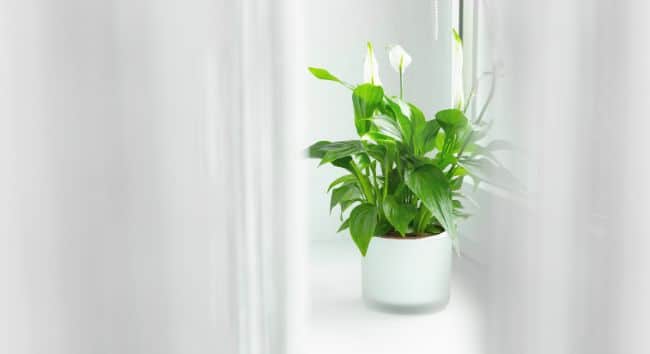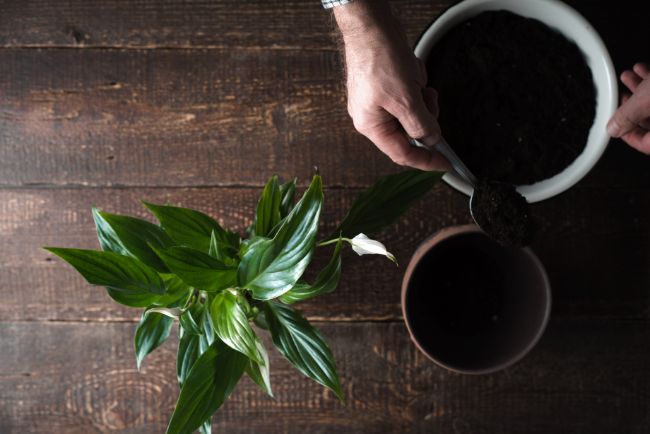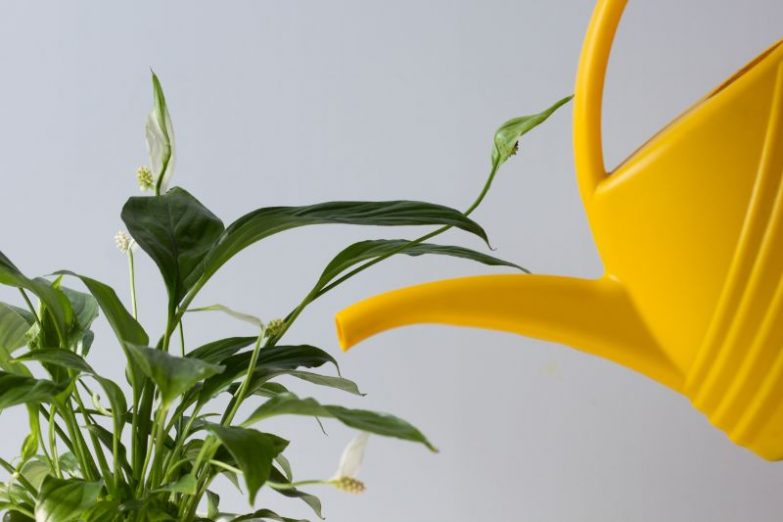With its glossy spear-shaped leaves and tall white flower spathes, the Peace Lily (spathiphyllum) makes for a great choice of houseplant. The most common problem with looking after Peace Lilies is overwatering. This article will help you identify the common Peace Lily overwatering symptoms, and show you how to restore your plant to perfect health.
The main symptoms of an overwatered Peace Lily are widespread yellowing foliage, brown leaf tips, generalized drooping, leaf spot diseases, and brown, mushy roots. A poorly draining pot or soil, overpotting, or watering on a schedule are major contributors to overwatering.
Peace Lily Overwatering Symptoms
It’s really easy to overwater your houseplants, and Peace Lilies (Spathiphyllum) are no exception. In fact, because Peace Lilies droop so spectacularly when underwatered, there is always the temptation to water them when in doubt.
The first symptom to look for is the foliage becoming paler and becoming generally yellow. This often affects the lower leaves more than upper leaves.
With continued overwatering, you may start to see small water blisters on the leaves and signs of leaf edema. If a Peace Lily continues to be overatered, the roots start to struggle, and other symptoms will soon develop.
The leaves can develop brown or black tips, brown edges and sometimes can be affected by bacterial or fungal disease, which will present as brown, black or yellow spots on the leaves.
Eventually, prolonged soggy conditions will cause root rot to set in, leading to a rotting smell emanating from the soil. If you inspect the roots at this point, you can expect them to be brown/black, mushy, fragile, and smelly. This is really bad news for your plant.
What Causes The Symptoms Of Overwatering
Interestingly, the first symptoms of overwatering are caused by the plant taking up too much water from the soil. The leaves swell as they become overfilled with water.
The next symptoms are caused when the roots start to malfunction and stop absorbing water. The soggy soil conditions are really not a healthy environment for the roots of your Peace Lily. It’s not the excess water thats the problem, but the lack of oxygen in the soil due to the waterlogged conditions.
Roots require oxygen to survive, and they normally receive plenty of this from the air-filled spaces in the soil. When water fills all these spaces, the roots soon use up the available oxygen.
The roots then start to suffocate and either die due to this or are attacked by bacterial or fungal pathogens that strike when the roots are weakened.

Factors That Increase The Risk Of Overwatering Your Peace Lily
Remember that overwatering is really any situation that causes your Peace Lily to sit in waterlogged soil for a prolonged period of time. Let’s look at the main factors that cause overwatering.
- Watering Too Frequently – Let’s start with the obvious one first. Don’t water your Peace Lily on a schedule. Wait until at least the top half of the soil feels dry to touch before watering. This can take anywhere from a few days to more than two weeks, depending on a range of factors.
- Pot Size – A small plant in a large pot is at high risk of being overwatered. The soil will remain wet for a long time after watering.
- Pot Material – Plastic, metal and glazed ceramic pots are non-porous. This results in less water loss from the soil. Terracotta and wood are porous and the soil will lose moisture through the walls of the pot.
- Forgetting To Empty The Drip Tray – It you leave the base of the pot sitting in water, root rot will quickly develop. Empty the drip tray or cache pot shortly after watering, ensuring that all the excess water has drained from the pot.
- Season – Peace Lilies grow much more slowly in winter, and the soil will take much longer to dry out after watering, increasing the risk of Peace Lily overwatering.
- Temperature And Airflow – Cold temperatures and lack of airflow reduce evaporation and transpiration, causing the soil to dry out more slowly after watering.
Peace Lily Overwatering Solutions
There are two main aspects to fixing an overwatered Peace Lily. I’m going to cover the immediate action you need to take in the section below. The other part is prevention, which comes from providing good growing conditions for your Peace Lily. I’ve written a separate article covering all aspects of Peace Lily care, which you may find helpful.
Repotting
One of the surest ways to revive a waterlogged plant is to repot it into a free-draining potting mix. You could wait for the current mix to drain but in extreme scenarios, repotting will get the plant out of the wet conditions much more quickly.
Tip the plant from its pot and remove as much of the wet soil as possible without breaking the roots. You can now replant it into the same sized pot or into a pot of the next size up.
This decision will be based on how large the root ball is. If it looks like it will fit comfortably into its current pot then use that again. If, on the other hand, the roots look like they are starting to become crowded then repot into the next sized pot.
Note – If there is any sign of root rot at all, repot in a clean plant pot and fresh potting soil. Reusing the same pot risks a recurrence of the problem.
Don’t be tempted to plant into a much larger pot as the excess soil will retain water and you risk recreating the boggy environment you are trying to cure.
Use a good quality house plant potting mix and add 1/3 perlite or coarse sand to improve drainage. Pack the soil lightly and don’t compact it too much as this will reduce both water flow and airflow around the root structure.
Normally the potting soil you purchase will come in a plastic bag and should be slightly moist. If that is the case, don’t water at all for the time being but give the plant a chance to catch its breath.

Watering
Only once the soil has started to dry out should you apply water. Don’t water on a schedule, but instead rely on checking the feel of the soil. This is most reliably done by plunging your finger into the growing medium.
With smaller plants in pots of less than six inches in diameter, the top 1-2 inches should be dry and anything deeper than that slightly moist. In pots larger than six inches, the top half of the soil can be allowed to become dry between waterings.
When you do start to water your Peace Lily again, apply water to the point that it is flowing from the drainage holes in the bottom of the pot. Wait a few minutes until excess water stops draining then tip any water in the saucer away and don’t water again until the soil meets the criteria just mentioned.
The reason I prefer to water when the top of the soil feels dry rather than on a weekly basis, for example, is that evaporation will vary according to local conditions.
Sometimes you will need to only water every 1-2 weeks and at others, every three to four days. The size of the plant will also affect the amount it transpires and this will in turn affect the soil moisture.
Even an inexperienced gardener will quickly become proficient at feeling for soil moisture retention. When growing houseplants, it is one of the most important skills to have.
Firstly, examine the pot and ensure that it has drainage holes and that these are not blocked. If there is not adequate drainage then the water lingers around the root system and rot is inevitable.
If drainage is not the issue then ensure that the saucer the pot is standing in does not contain water. That water in the saucer will prevent the pot from draining and, once again you have created a bog rather than a free-draining soil.
Feeding
Once you have repotted your overwatered plant don’t feed it immediately. A plant weakened by overwatering can experience more stress by being fertilized after being repotted.
Avoid applying any fertilizer for 3 months and only after that should you get onto a feeding schedule. Feeding encourages regrowth and for the time being, we want to focus on recovery.
After about one month you can start feeding your plant with a balanced house plant fertilizer. Feed it once a month during the growing season and then drop back to once every two months during the winter.
Lighting
Once you have corrected any drainage problems and repotted the plant then move the plant to a position where it is in bright light but not direct sun. This is the plants preferred growing condition and the gardener does not want to exacerbate an overwatering problem with a lighting problem.
In its natural environment, this plant grows in the shade of other plants. It likes light but not sun. In the case of a plant already weakened by overwatering, its ability to recover from direct sunlight would be severely compromised.
Temperature
Ideally, the Peace Lily likes to be at temperatures of between 65-80°F (18-27°C). Although normally tolerant of temperatures outside of this range, a healthy plant would be unhappy at anything below 40°F (4°C).
Your plant is in recovery mode and I would recommend keeping it within the boundaries of the ideal range if possible. Also, try to ensure that it is not exposed to any drafts.
Humidity
Humidity is another factor to take into account with Peace Lilies. They come from humid tropical environments and dry air in houses and apartments is not necessarily ideal for them. If you are able to surround them with companion plants, they will create their own micro-system and should keep each other humid enough.
If that is not an option then lay some pebbles in the plant saucer and fill it with water to just below the surface of the pebbles. The base of the plant should be clear of the water but the steady evaporation will raise humidity levels.
In Conclusion
Peace Lily overwatering is the most common problem when caring for this wonderful houseplant, but it can easily be prevented by following the advice in this article.
Don’t worry too much if your plant is beyond repair, as growing houseplants is a continual learning experience. I definitely learn far more from my failures than my successes, so take the positives from every experience.
If you’d like to avoid all the common houseplant problems and grow vibrant healthy plants that thrive year after year, check out my book, Houseplants Made Easy. I cover everything you could possibly want to know about growing beautiful houseplants.

